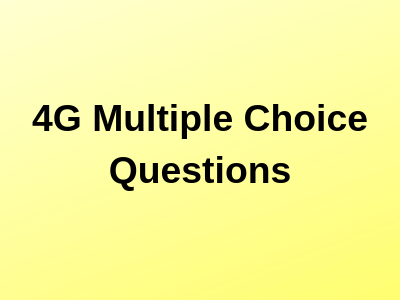4G Multiple Choice Questions:-
1) As of December 15th, 2011 Verizon Wireless has brought 4G LTE to over ______ million people?
A. a. 100
B. b. 150
C. c. 200
D. d. 250
Ans: c
2) What are the average upload speeds of our 4G LTE network?
A. a. 1-3 Mbps
B. b. 2-5 Mbps
C. c. 1-3 Mbps
D. d. 2-5 Mbps
Ans: d
3) 4G LTE is ____ times faster than 3G?
A. a. 5
B. b. 10
C. c. 15
D. d. 20
Ans: B
4) What are the average download speeds for our 4G LTE network?
A. a. 1-2 Mbps
B. b. 5-12 Mbps
C. c. 1-2 Mbps
D. d. 5-12 Mbps
Ans: D
5) Which of these are not part of the characteristics of 4G?
(a) Software Dependency
(b) Fully Converged Services
(c) Diverse User Devices
(d) Ubiquitous Mobile Access
(e) Multirate management
Ans: e
6) What does SGSN stand for?
(a) Serial Gateway Supporting Node
(b) Supporting GPRS Support Node
(c) Supporting GGSN Support Node
(d) Supporting Gateway Supporting Node
Ans: b
7) What does MSC stand for?
(a) Master Sequence Controller
(b) Master Switching Controller
(c) Master Switch Controller
(d) Master Switching Control
Ans: b
8) What is the expected maximum data rate for 4G?
(a) 100Mbps
(b) 100Kbps
(c) 10Mbps
(d) 200Kbps
Ans: a
9) What application will require BlueTooth?
(a) Ad-Hoc Networking
(b) Desktop Publishing
(c) Circuit Switching
(e) Packet Networking
Ans: a
10) What are some of the major architectural differences exist between 3G and 4G?
(a) The RNC acts as a BS in a cluster-type RAN configuration.
(b) The circuit-switching elements are removed in 4G.
(c) A VOIP Gateway is used to connect to the PSTN and ISDN networks
(f) All of the Above
Ans: d
11) Which of these is not a function of the Service Middleware in the IP Core Network?
(a) Media Conversion
(b) Radio Resource Management
(c) Wireless Data transmission
(d) Mobility Management
Ans: c
12) Why are cell sizes likely to be smaller in 4G?
(a) Higher frequency bands are utilized for data transmission
(b) At higher data rates the signal must be received at a higher SNR threshold.
(c) A and B
(d) Data is transmitted at lower power
(e) A and D
Ans: c
13) What Location Management feature does 4G support?
(a) Concurrent Location Registration
(b) Concatenated Management
(c) Collated Location Registration
(d) Concatenated Location Registration
Ans: d
14) In the clustered diversity hand-over scheme that is used in 4G, the __________ is dynamically assigned to perform signal-processing combine the multiple signals into one:
(a) Temporal Agent
(b) Cluster Head
(c) Cluster Agent
(d) Temporary Cluster Head
Ans: a
15) Question 3: 4G enabled the third generation systems, such as IS-2000, UMTS, HSXPA, ________, TD-CDMA, and TD-SCDMA, to use CDMA as the access scheme.
A. Evolution-Data Optimized
B. High-Speed Downlink Packet Access
C. UMTS-TDD
D. WiMAX
Ans: A
4G Objective Questions Pdf Free Download::
16) On December 9, 2008, ________ announced that they intend to build and begin to roll out an LTE network by the end of 2009.
A. Vodafone
B. Netflix
C. V Cast
D. Verizon Wireless
Ans: D
17) On September 20, 2007, ________ announced that it plans a joint effort with the Vodafone Group to transition its networks to the 4G standard LTE.
A. AirTouch
B. Netflix
C. Verizon Wireless
D. V Cast
Ans: C
18) The ________ evolution of 802.16e is under development, with the objective to fulfill the IMT-Advanced criteria of 1000 Mbit/s for stationary reception and 100 Mbit/s for mobile reception.
A. IEEE 802.11
B. Token ring
C. IEEE 802.16
D. WiMAX
Ans: D
19) ____________ to attain ultra-high spectral efficiency by means of spatial processing including multi-antenna and multi-user MIMO
A. 3G MIMO
B. MIMO
C. WiMAX
D. Beamforming
Ans: B
20) The pre-4G technology ________ (LTE) is often branded “4G”, but the first LTE release does not fully comply with the IMT-Advanced requirements.
A. E-UTRA
B. WiMAX
C. 3GPP Long Term Evolution
D. Universal Mobile Telecommunications System
Ans: C
21) So in second generation systems, one set of the standard used the combination of FDMA and TDMA and the other set introduced an access scheme called ________.
A. Media Access Control
B. Multi-carrier code division multiple access
C. Orthogonal frequency-division multiple access
D. Code division multiple access
Ans: D
22) Smooth ________ across heterogeneous networks,[7]
A. CDMA2000
B. Cellular network
C. Handoff
D. Universal Mobile Telecommunications System
Ans: D

